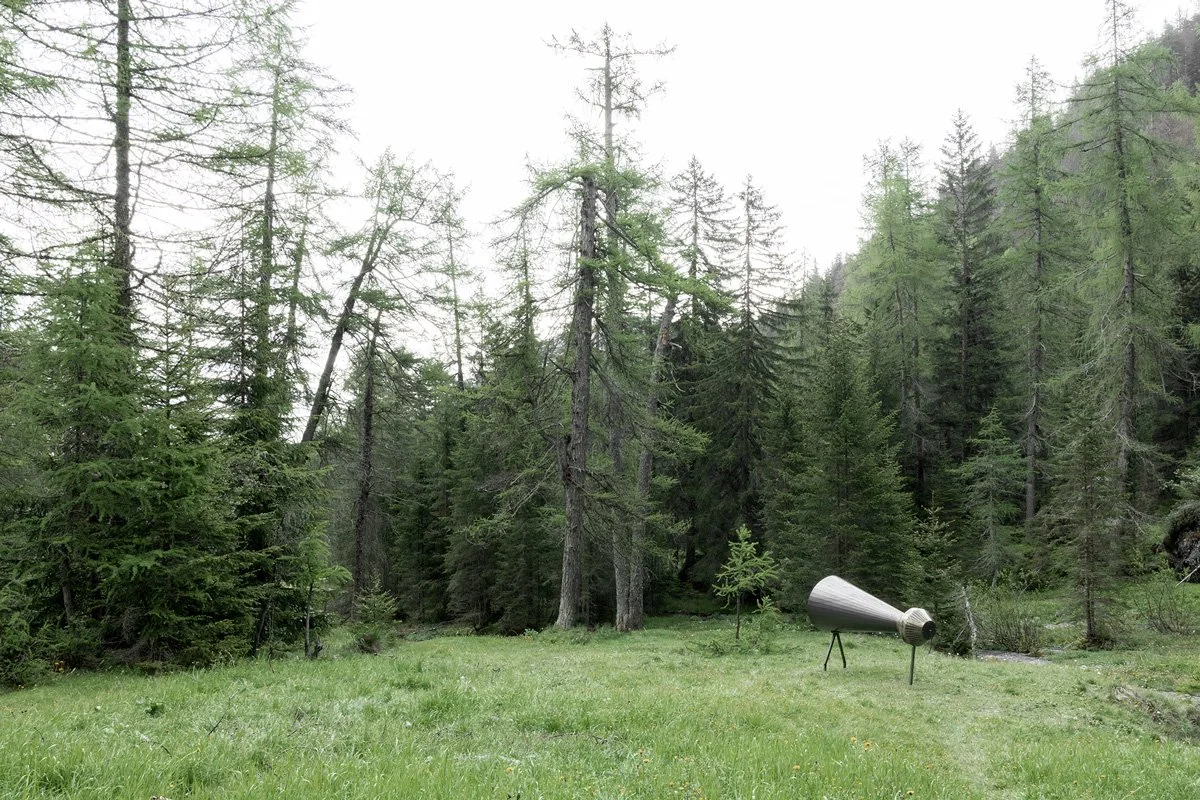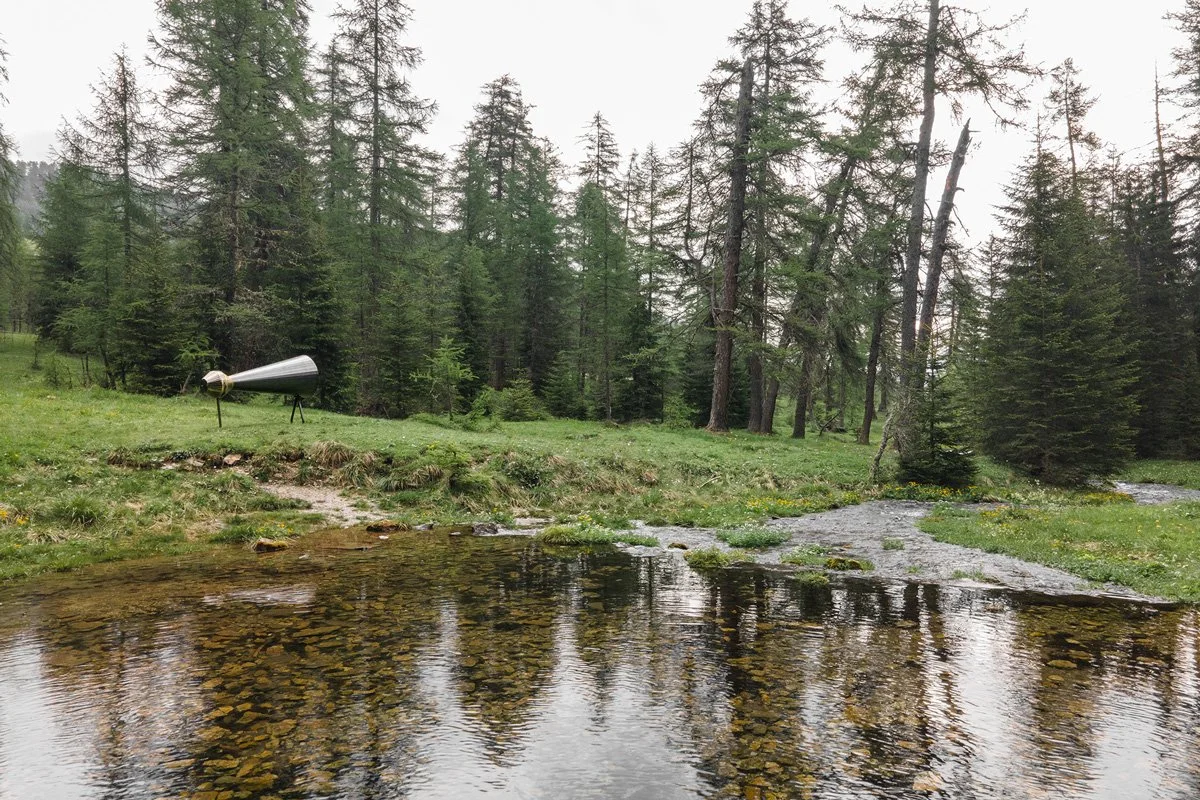Atelier Simondi, Officina Fabre, Prometheus APS
“iCù”
Italy
Place: Pares
The sound installation “iCÙ” allows anyone who wishes to listen to an ancient and mysterious sound. By turning the crank, the sound will be produced by the artwork created by Matteo Simondi in collaboration with Associazione Prometheus and Officina Fabre. The Piedmontese architect conceived the concept and designed the structure, which was then realized through collaboration with two initiatives dedicated to the preservation and transmission of ancient artisanal knowledge: Prometheus, based in Dronero (CN), disseminates the art of manual scything, while Fabre, located in Berzo Inferiore (BS), focuses on metal forging, starting from an unusual object: the hoe mold. This year’s SMACH Biennale theme also stems from the inspiration provided by an agricultural tool: the whetstone. What you will hear by activating the installation—a kind of “noise-intoning machine” that nods to Luigi Russolo—is, in fact, the sound made by the stone when sharpening the blade of a scythe.
-
L’istalaziun sonora “iCÙ” ti dá la poscibilité a che che ó, da ascuté na vera antica y misteriosa. Rodan la mantia vëgnel realisé le sonn dl’opera de Matteo Simondi fata en colaboraziun cun l’Assoziaziun Prometheus y l’Officina Fabre. L’architët dl Piemont á ideé le conzet y dessigné la strotöra realisada spo dilan ala colaboraziun cun döes scomenciadies che se dá jö cun la sconanza y trasmisciun de conescënzes artejanales antiches: Prometheus cun la sënta a Dronero (CN), trasmët le savëi da sié cun la falc, deperpo che Fabre, cun la sënta a Berzo Inferiore (BS), dá inant chël da fujiné le metal pian ia da n oget particolar: le stamp dla sapa. Ince la tematica dl’ediziun da chësc ann dla SMACH Bienala nasc dai impulsc dá da na massaria agricola: la cu. Ci che i aldiarëis ativan l’istalaziun – na sort de “mascin che fej veres” y n tribut a Luigi Russolo – é la vera che la cu fej deperpo ch’an agüza la falc.
-
L’installazione sonora “iCÙ” permette, a chi lo vuole, di ascoltare un rumore antico e misterioso. Girando la manovella il suono verrà prodotto dall’opera realizzata da Matteo Simondi in collaborazione con Associazione Prometheus e Officina Fabre. L’architetto piemontese ne ha ideato il concetto e disegnato la struttura poi realizzata grazie alla collaborazione con due iniziative che si occupano della tutela e trasmissione di conoscenze artigianali antiche: Prometheus, di base a Dronero (CN), diffonde il sapere dello sfalcio manuale, mentre Fabre, con sede a Berzo Inferiore (BS), quello della forgiatura del metallo a partire da un oggetto inusuale: lo stampo da zappa. Anche la tematica dell’edizione di quest’anno della SMACH Biennale nasce dagli spunti dati da uno strumento agricolo: la pietra cote. Quello che sentirete attivando l’installazione - una sorta di “macchina intonarumori” che strizza l’occhio a Luigi Russolo - è infatti il rumore che fa la pietra nell’affilare la lama della falce fienaia.
-
Die Klanginstallation “iCÙ” lässt ein altes, geheimnisvolles Geräusch hörbar werden: den Klang des Wetzens einer Sense. Durch Drehen der Kurbel erzeugt das Werk dieses Geräusch – eine Hommage an Luigi Russolo und seine „Geräuschmaschinen“. Entworfen von Matteo Simondi und realisiert mit der Associazione Prometheus (Dronero) und Officina Fabre (Berzo Inferiore), verbindet “iCÙ” Wissen über das manuelle Mähen und das Metallschmieden. Wie das Thema der diesjährigen SMACH Biennale, geht auch dieses Werk von einem traditionellen Werkzeug aus: dem Wetzstein.









How to reach the location
Location PARES.
When we look at the forest, we often think it is a product of nature, but the larch forest in this area is actually the result of human activity. For over a thousand years, the community of Longiarù has managed and shaped it. The larch is, in fact, the most economically important tree for mountain communities, not only in these mountains but throughout the Alps. For the high valley inhabitants, the larch was as crucial as the chestnut was for those in the lower valleys. Thus, these forests have been protected for centuries and used only to the extent strictly necessary. Its use has been intense and varied: it has served as cradle and coffin, in the making of sacred objects, for shelter and warmth, as home decoration, and as a tool for daily work.
The Latin name is Larix decidua, which is thought to derive from the Celtic word lar meaning “fat,” due to its high resin content. The term decidua indicates that it is the only native conifer that sheds its needles in autumn and winter. Another important feature is its light canopy, allowing a great deal of sunlight to reach the forest floor. Therefore, larch forests are considered silvopastures – habitats created by humans through selective thinning, favoring these conifers to allow dual exploitation of the land: timber production and grass for animals.
Additionally, larch fungi and lichens were (and still are, to some extent) used in herbal medicine. For example, the mushroom Fomitopsis pinicola was used to stop bleeding, while lichens of the Usnea genus have antibiotic properties due to their content of usnic acid.
Lastly, nearby are the Lagac springs (Natural Monument 083_G04). This is one of those hidden, isolated places where humans can experience the forces emanating from nature. The element of water, significant in myths and legends (the Ganes always lived near springs or lakes), creates synergies to ignite the imagination and spirit of those who can pause in this place.
-
Sc’an ti ciara al bosch spo pënson ch’al sides früt dla natöra, mo le larjëi de chësta zona é deperpo früt dl’ativité umana. Al é deplü co mile agn che la comunité da Longiarü curëia la gestiun y ti dá forma a chësc bosch. Le lersc é le lëgn plü important, a livel economich, por les civilités da munt nia ma de chëstes munts, mo de dötes les Alpes. Por i abitanc dles valades plü alalt é le lersc ci che le lëgn da ciastëgnes é por les popolaziuns dles valades albas y sü bosć vëgn sconá da secui y adorá ma por ci che é veramënter nezesciar. Süa adoranza é grana y desvalia: le lignan de lersc gnô adoré por les cünes y por i scrins; por fá ogec sacri; al dê assosta y cialt; al gnô adoré sciöche ornamënt dla ciasa y stromënt de laur da vigni de.
L’inom latin é “Larix decidua”, che dess gní dal celtich “lar”, gras, deache dër da arjina, deperpo che l’inom decidua dá dant ch’al é le su lëgn da odlina chiló da nos che perd l’odlina da d’altonn y d’invern. N ater aspet important é süa odlina fina che lascia filtré tröpa löm ia por tera. I larjëis vëgn insciö conscidrá sciöche pastöres da lëgns. Habitat cheriá dala porsona tignin i bosć plü speri te na manira seletiva, por podëi anuzé dui iadi la suraspersa:
por la produziun de lignan y por l’erba da vardé.Implü, fonguns y barbücia, che gnô adorá tla fitoterapia. Por ejëmpl: Le fongun Fomitopsis pinicola gnô adoré por tigní sö les emoragies, deperpo che la barbücia dla sort Usnea gnô
adorada por süa aziun antibiotica dilan al contignü de aje usnich.Ala fin, chiló dlungia, él les fontanes de Lagac (monumënt natural 083_G04). Un de chi posć ascognüs y isolá olache la porsona vëgn pro da sintí les forzes dla natöra. L’elemënt dl’ega, important ti mic y tles liëndes (les Ganes viô tres daimpró da val’ fontana o lech), cheriëia sinergies por ti dé ares ala fantasia y al spirit de chël che s’intopa da se tigní
sö te chësc post. -
Guardando il bosco pensiamo che esso sia frutto della natura, ma il lariceto di questa zona è invece frutto dell’attività umana. Sono oltre mille anni infatti che la comunità di Longiarù ne cura la gestione e gli da forma. Il larice è, infatti, l’albero più importante, a livello economico, per le civiltà montanare non solo di questa valle, ma di tutte le Alpi. Per gli abitanti delle alte valli, il larice è ciò che fu il castagno per le popolazioni delle basse valli e le sue foreste sono perciò protette da secoli e utilizzate solo nella misura strettamente necessaria. L’utilizzo del suo legno è intenso e variegato: fu impiegato come culla e bara; nella fabbricazione di oggetti sacri; fornì riparo e calore; servì come ornamento della casa e strumento del lavoro quotidiano.
Il nome latino è “Larix decidua” deriverebbe dal celtico “lar”, grasso, in quanto molto resinoso. Mentre l’appellativo decidua indica che è l’unica conifera nostrana che perde gli aghi in autunno e in inverno. Un altro aspetto importante è che la sua chioma leggera lascia filtrare molta luce al suolo. I lariceti sono considerati, infatti, l’albero ideale dei pascoli alberati. Habitat creati dall’uomo diradando i boschi in maniera selettiva favorendo queste conifere per permettere un doppio sfruttamento della superficia: per la produzione di legname
e di erba per gli animali.Inoltre, funghi e licheni del larice erano (e ancora in parte sono) utilizzati nella fitoterapia. Per esempio: Il fungo Fomitopsis pinicola veniva utilizzato per arrestare le emorragie, mentre i licheni del genere Usnea hanno azione antibiotica in virtù del loro contenuto di acido usnico. Infine, qui vicino si trovano le risorgive Lagac (monumento naturale 083_G04) circondate da larici secolari. Uno di quei luoghi nascosti e isolati dove l’uomo può esperire le forze emanate dalla natura. L’elemento dell’acqua, importante anche nei miti e nelle leggende (le Ganes vivevano sempre nei pressi di qualche sorgente o lago), crea sinergie per far involare la fantasia e lo spirito di colui che saprà sostare in questo luogo.
-
Wenn wir den Wald betrachten, denken wir, dass er ein Produkt der Natur ist, aber der Lärchenwald in diesem Gebiet ist tatsächlich das Ergebnis menschlicher Tätigkeit. Seit über tausend Jahren pflegt und gestaltet die Gemeinschaft von Longiarù diesen Wald. Die Lärche ist nämlich der wirtschaftlich wichtigste Baum für die Bergvölker nicht nur in diesem Tal, sondern der gesamten Alpen. Für die Bergbewohner ist die Lärche das, was die Kastanie für die Bewohner der Tieftäler war, und ihre Wälder werden daher seit Jahrhunderten geschützt und nur im unbedingt notwendigen Maße genutzt. Ihre Verwendung ist vielfältig und intensiv: Sie diente als Wiege und Sarg; bei der Herstellung heiliger Objekte; sie bot Schutz und Wärme; sie diente als Schmuck für das Haus und als Werkzeug für die tägliche Arbeit.
Der lateinische Name Larix decidua leitet sich wahrscheinlich vom keltischen larab, was „fett“ bedeutet, da sie sehr harzreich ist. Das Beiwort decidua weist darauf hin, dass sie die einzige heimische Nadelbaumart ist, die im Herbst und Winter ihre Nadeln verliert. Ein weiteres wichtiges Merkmal ist, dass ihre lichte Krone viel Licht auf den Waldboden durchlässt. Lärchenwälder gelten daher als Baumweiden. Es handelt sich um vom Menschen geschaffene Lebensräume, in denen die Wälder durch selektives Auslichten gestaltet wurden, um diesen Nadelbaum zu fördern und eine doppelte Nutzung der Fläche zu ermöglichen: die Holzproduktion und die Gewinnung von Gras für die Tiere.
Außerdem wurden Pilze und Flechten der Lärche in der Phytotherapie verwendet (und werden teilweise noch immer genutzt). Zum Beispiel: Der Pilz Fomitopsis pinicolawurde verwendet, um Blutungen zu stoppen, während Flechten der Gattung Usnea aufgrund ihres Gehalts an Usninsäure eine antibiotische Wirkung haben. In der Nähe befinden sich auch die Quellen von Lagac (Naturdenkmal 083_G04). Dies ist einer jener verborgenen und abgelegenen Orte, an denen der Mensch die Kräfte der Natur erleben kann. Das Element Wasser, das auch in Mythen und Legenden eine wichtige Rolle spielt (die Ganes lebten immer in der Nähe von Quellen oder Seen), schafft Synergien, um die Fantasie und den Geist desjenigen zu beflügeln, der an diesem Ort verweilen kann.
